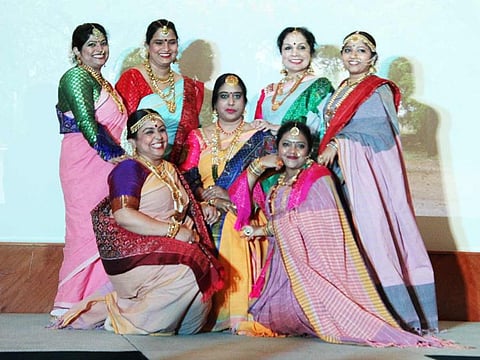150th birth anniversary of Mahatma Gandhi celebrated in Dubai with a tribute to khadi
AHC members take a pledge to do their bit to leave the earth liveable for next generation

Dubai: The Gulf Saree Pact, which has renamed itself as the AHC (Ambassadors of Heritage & Crafts) Foundation, marked the 150th birth anniversary of Mahatma Gandhi, observed on October 2, with a tribute to khadi (handspan cloth) on September 27 in Dubai.
AHC could not have chosen a better theme for the event than ‘Swavlamban’ (self-reliant). Mahatma Gandhi, India’s Father of the Nation and an ambassador of peace, believed that ‘swaraj’ or self-rule was possible through non-cooperation and self-reliance. And charkha, the spinning wheel, became his symbol for swaraj.
Gandhi lived his philosophies by wearing the dress of the Indian peasant. But his dream of seeing the whole country clothed in khadi remains unfulfilled.
To rekindle interest in this fabric among its members, the AHC has taken several initiatives.
As part of their annual ‘Weaver Initiative’ project, this year they chose khadi in a bid to revive local textiles in India. Led by a seven-member team, they entered into a year-long working relationship with Gandhigram in Tamil Nadu, one of India’s oldest rural support organisations established under Gandhi’s patronage, said Effie Thomas, founder of AHC.
The initiative, which aims to eliminate any middlemen between the weaver and the buyer, is aptly named Arabhya, a Sanskrit word for ‘beginning with’. Their journey began from conception to owning the weaving cycle — from yarn to the entire six yards. The result: stunning khadi saris in various styles in pastel and earthy colours.
Some of those creations were on display with a group of AHC members presenting them on the ramp. It was a display that was more about commemorating Gandhi’s birth anniversary than be viewed as only a fashion show.
Models in trendy khadi outfits emphasised the allure of the garments, leaving little doubt that khadi could pose a serious challenge to other fabrics in the fashion rankings. The designs, created exclusively for Swavlamban by Reshmi Padikkal and Lalitha Alexander, were defined by their beauty and elegance.
Vino Supraja, a fashion designer based in Dubai, who now campaigns for ‘Sustainable Fashion’, spoke about the ugly side of the fashion industry. It is the second most polluting and violent industry on the earth, she said, during her presentation. She explained her use of the term ‘violence’: Cotton, she said, uses more pesticides and insecticides than any other crop. Organic cotton is a misnomer, she explained, adding that it makes up for only one per cent of the total cotton produced and used.
Add to this the fact that every second around the world, a big truck full of used, discarded clothes are being dumped in landfills. “We can fill one and a half times of the [volume of] the Empire State Building every day and fill up the entire Sydney Harbour every year with used clothes,” Supraja says.
There’s also the violence on water: For producing just a kilo of cotton, we require more than 10,000 litres of water, said Supraja. “And to produce one T-shirt we need 2,700 litres of water, which is equal to 900 days of drinking water required for an average man. And how many T-shirts do we have in our wardrobe? she wondered. Everyone, she said, needs to examine how they are contributing to this violence.
Further, only 80 per cent of the dyes are absorbed by the fabric while the rest goes into rivers that are used by the underprivileged for their daily water needs, she said. “Not all can afford bottled drinking water like us.”
Is polyester an answer to these problems? “It’s worse,” she responded. Polyester is no less polluting than plastic, according to her. It takes 200 years to decompose and every time we wash polyester clothes, the micro fibres eventually find their way into oceans.
Another fact she presented: To produce a single pair of jeans, 4,000 mega joules of energy is being used, which is equal to one electricity bulb lit continuously for 150 days!
The AHC event included a Kathak dance by its members and ended with a pledge by all to do their bit to leave the earth liveable for the next generation.
Sign up for the Daily Briefing
Get the latest news and updates straight to your inbox



